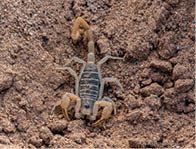Return to 2nd Quarter 2023 articles.



An environmental design feature we often overlook is the need to control insect populations. Insects do many good things, but if their numbers are not controlled, they can wipe out other forms of life — especially plants. Giant sand scorpions (Smeringurus mesaensis) help control insects in the Mohave Desert using a method similar to how geologists locate earthquake epicenters.
Earthquakes generate longitudinal and transverse waves. Longitudinal waves travel faster. Close to the earthquake epicenters, the two wave types arrive at about the same time, but the time difference becomes greater farther from the epicenter. Geologists can accurately compute the earthquake's epicenter by measuring the difference at various locations.
Sand scorpions use a similar technique to locate their prey. The scorpion has eight legs that can detect vibrations of one angstrom (which is the size of a hydrogen atom). An insect traveling either under the surface or on the surface of the ground creates tiny vibrations. The scorpion detects the direction of the prey by comparing when its legs receive the signal from the prey's movement. Legs closer to the prey detect the signal before legs further away, and the time difference between the two types of waves is a few microseconds.
The scorpion can compute the distance and direction to the prey by comparing the time difference. It then moves in that direction and stops at the distance indicated by the arrival times of the vibration. Then, stabbing with its pincers at that point, it gets its meal without seeing its prey.
Using a method similar to how geologists locate earthquake epicenters, sand scorpions, hunting primarily at night, can control insect populations in the Mohave Desert. The many ways the natural system maintains balance is an excellent testimony for design. The creation is not an accident but the product of a Supreme Intelligence that has built these systems into our world.
Picture credits:
© AlessandraRC. Image from BigStock.com
